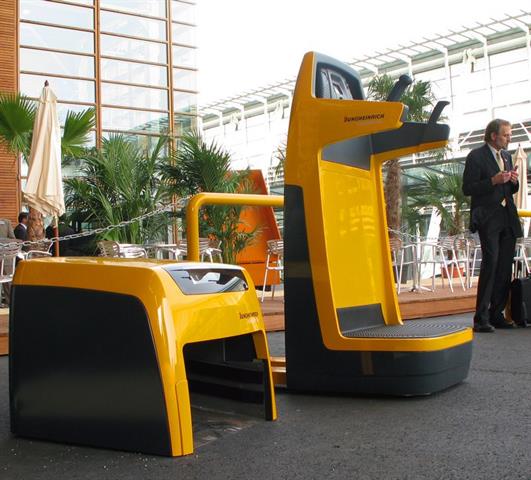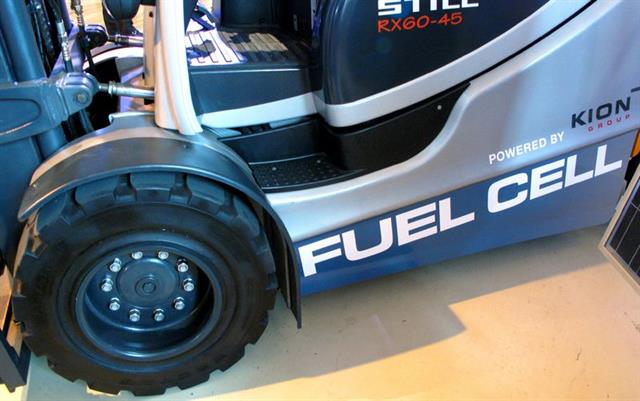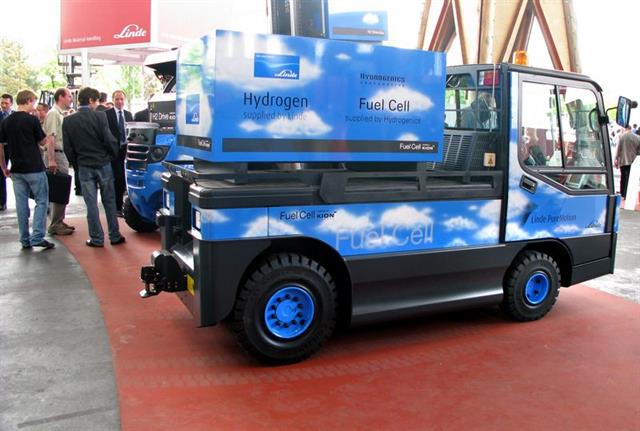 Jungheinrich's Concept 08 |
By Luc De Smet
Alternative fuel sources were the talk of CeMAT 08, with manufacturers unveiling their developments. Hydrogen and hybrid vehicles are still mostly in R&D or test stage, but Lithium Ion batteries are taking off.
Lithium Ion batteries (Li-Ion), currently used in cell phones and iPods, are lighter and more powerful than lead batteries. They also provide designers with more freedom of form. They require less energy, run and live longer - and have a host of other benefits. But some challenges still remain, including the need for efficient charging technology. Higher costs of the basic materials could become a concern. Forklift builders will also need to put in some extensive testing before the technology hits the market.
Jungheinrich's slender Concept 08 - a concept study for a stand-on AC pallet truck - has seven Chinese 3,6V Li-Ion battery cells neatly integrated into its mast. This prototype is claimed to be some 15% more efficient than a machine with traditional batteries. The Concept 08 will probably never hit the market, but components and subsets may eventually be integrated into various models of Jungheinrich's broad range of warehouse machines.
Nissan showed off its first forklift running on Li-Ion batteries, the result of last year's joint venture between Nissan Motor Co, NEC Corporation and NEC TOKIN. Automotive Energy Supply Corporation (AESC) first aimed at the automotive market, but in the meantime it is also applying its findings to forklifts. It is said that testing will start at a Japanese client in 2010. We also heard that Nissan soon will be launching a hybrid car that runs on Li-Ion-batteries. It again illustrates the relationship and synergy between automotive and materials handling.
Noblelift, a major Chinese builder of warehouse machinery, discretely showed its manual palletiser with a built in Li-Ion battery.
Hybrids and others Still AG is the first to have a hybrid truck close to initial series production. The RX 70 hybrid runs on diesel and electricity it stores in "SuperCaps". These supercapacitators draw a high current that is recuperated when braking or when lowering the forks. They give the machine a 'boost' when needed, alongside the output of the combustion engine. When accelerating or during operational peaks, the SuperCaps will lower the revs per minute (rpm) of the diesel engine by as much as 30%. The RX 70 Hybrid comes to the fore in applications with start-stop operations and accelerating. Across the board savings in fuel are estimated at 11%.
 Still Fuel Cell |
Still has more up its sleeve: it has been testing two R07-25 towtractors with fuel cells at Hamburg airport. In the port of Hamburg, Still is also trialing one of its R 60-25 forklifts on hydrogen. It plans to pilot a FM-X 20 reachtruck and a R 60 electric forklift with various alternative propulsion systems at BASF's Coatings facility. Over the next four years, Still plans to test some 100 trucks all over Germany to gain experience.
Forklift builder Linde showed three pilot machines on alternative fuels. Its blue hydrogen-powered P250 puller is practically appropriate for small initial series production. The company also showed its hybrid H35 concept forklift that has a 30 kW combustion engine and a synchronous electric motor, a 400 V Li-Ion battery and an energy management system. When standing still, the combustion engine will automatically turn off. The machine uses its electric motor as a generator or to restart the engine. This 'mild' combination can save up to a quarter in fuel consumption. The third truck, a 39x , is a three ton machine with a 'hydrogen motor' that burns directly injected hydrogen.
 Linde H2 |
Toyota demonstrated its Hybrid Concept Forklift in Hannover. It uses the same technology as its succesful hybrid car, the Prius. The machine combines a combustion engine and an electric generator along with a Ni-MH battery. Toyota has two versions of this machine: the demonstration model that runs the trade show circuit and the real test model at its Takahama R&D facilities in Japan. Nothing was heard about the fuel cell truck that Toyota showed three years ago at CeMAT.
OdditiesAt CeMAT08 Fronius, the Austrian builder of controls for welding apparatus and battery chargers and now also a world leader in photovoltaic panels, demonstrated its Energy Cell. It built it on a Linde's P30 Zug 050 warehouse tow truck. The H2-fuelcell - a PEM (polymer elektrolyte) - works at low temperatures (60 to 80°C). Fronius uses solar panels on the roof of its Sattledt-factory to generate the necessary hydrogen to run the machine.
Fronius sees its Energy Cell as a 'total concept' and envisions applications in material handling and cleaning machines with cells of 2kW/24V and 4 kW/48V. The Hylog has a handy 'mains' that can be tapped into for 230V 50Hz alternate current.